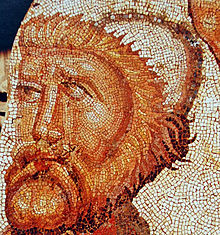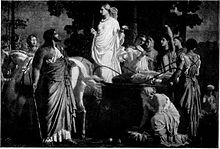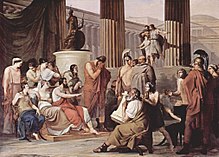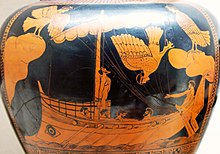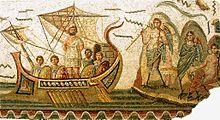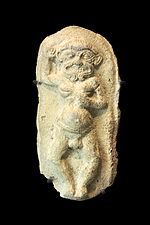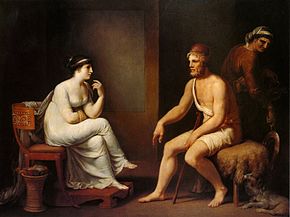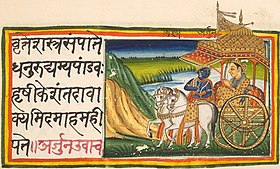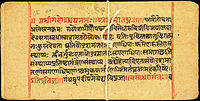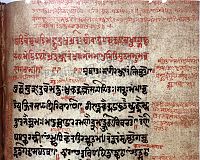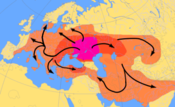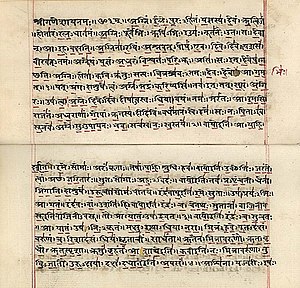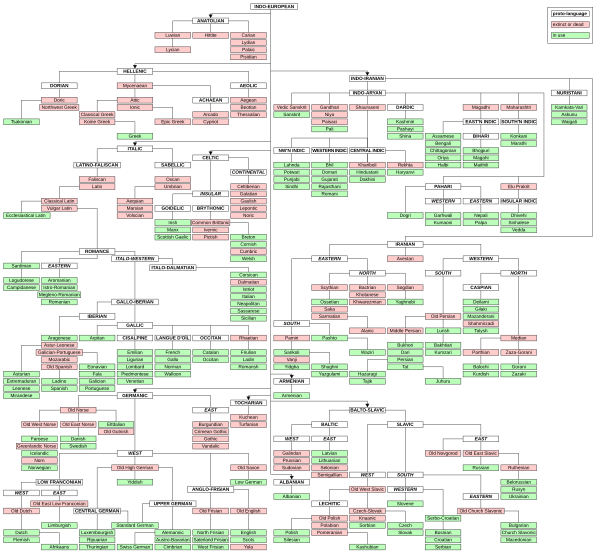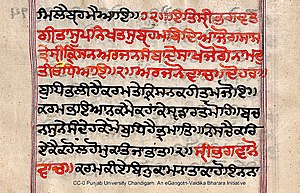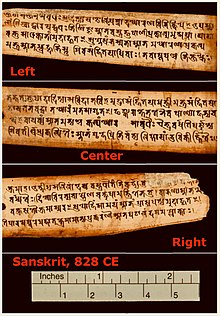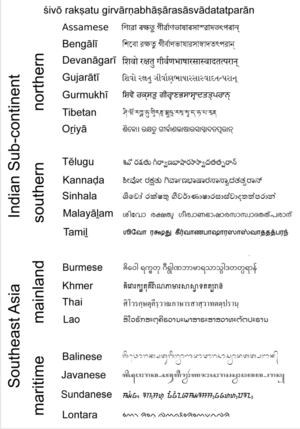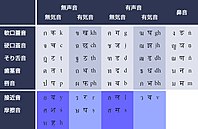From Wikipedia, the free encyclopedia
Sanskrit (, attributively संस्कृत-, saṃskṛta-, nominally संस्कृतम्, saṃskṛitam) is a classical language of South Asia belonging to the Indo-Aryan branch of the Indo-European languages. It arose in South Asia after its predecessor languages had diffused there from the northwest in the late Bronze age. Sanskrit is the sacred language of Hinduism, the language of classical Hindu philosophy, and of historical texts of Buddhism and Jainism. It was a link language in ancient and medieval South Asia, and upon transmission of Hindu and Buddhist culture to Southeast Asia, East Asia and Central Asia in the early medieval era, it became a language of religion and high culture, and of the political elites in some of these regions.
As a result, Sanskrit had a lasting impact on the languages of South
Asia, Southeast Asia and East Asia, especially in their formal and
learned vocabularies.
Sanskrit generally connotes several Old Indo-Aryan varieties. The most archaic of these is Vedic Sanskrit found in the Rig Veda,
a collection of 1,028 hymns composed between 1500 BCE and 1200 BCE by
Indo-Aryan tribes migrating east from what today is Afghanistan across
northern Pakistan and into northern India.
Vedic Sanskrit interacted with the preexisting ancient languages of
the subcontinent, absorbing names of newly encountered plants and
animals; in addition, the ancient Dravidian languages influenced Sanskrit's phonology and syntax. "Sanskrit" can also more narrowly refer to Classical Sanskrit,
a refined and standardized grammatical form that emerged in the mid-1st
millennium BCE and was codified in the most comprehensive of ancient
grammars, the Aṣṭādhyāyī ("Eight chapters") of Pāṇini. The greatest dramatist in Sanskrit Kalidasa wrote in classical Sanskrit, and the foundations of modern arithmetic were first described in classical Sanskrit. The two major Sanskrit epics, the Mahabharata and the Ramayana, however, were composed in a range of oral storytelling registers called Epic Sanskrit which was used in northern India between 400 BCE and 300 CE, and roughly contemporary with classical Sanskrit.
In the following centuries Sanskrit became tradition bound, stopped
being learned as a first language, and ultimately stopped developing as a
living language.
The hymns of the Rigveda are notably similar to the most archaic poems of the Iranian and Greek language families, the Gathas of old Avestan and Illiad of Homer. As the Rigveda was orally transmitted by methods of memorisation of exceptional complexity, rigour and fidelity, as a single text without variant readings, its preserved archaic syntax and morphology are of vital importance in the reconstruction of the common ancestor language Proto-Indo-European.
Sanskrit does not have an attested native script: from around the turn
of the 1st-millennium CE, it has been written in various Brahmic scripts, and in the modern era most commonly in Devanagari.
Sanskrit's status, function, and place in India's cultural heritage are recognized by its inclusion in the Constitution of India's Eighth Schedule languages. However, despite attempts at revival, there are no first language speakers of Sanskrit in India. In each of India's recent decadal censuses, several thousand citizens have reported Sanskrit to be their mother tongue, but the numbers are thought to signify a wish to be aligned with the prestige of the language. Sanskrit has been taught in traditional gurukulas since ancient times; it is widely taught today at the secondary school level. The oldest Sanskrit college is the Benares Sanskrit College founded in 1791 during East India Company rule. Sanskrit continues to be widely used as a ceremonial and ritual language in Hindu and Buddhist hymns and chants.
Etymology and nomenclature
Historic Sanskrit manuscripts: a religious text (top), and a medical text
In Sanskrit verbal adjective sáṃskṛta- is a compound word consisting of sam (together, good, well, perfected) and krta- (made, formed, work). It connotes a work that has been "well prepared, pure and perfect, polished, sacred".
According to Biderman, the perfection contextually being referred to in
the etymological origins of the word is its tonal—rather than
semantic—qualities. Sound and oral transmission were highly valued
qualities in ancient India, and its sages refined the alphabet, the
structure of words and its exacting grammar into a "collection of
sounds, a kind of sublime musical mold", states Biderman, as an integral
language they called Sanskrit.
From the late Vedic period onwards, state Annette Wilke and Oliver
Moebus, resonating sound and its musical foundations attracted an
"exceptionally large amount of linguistic, philosophical and religious
literature" in India. Sound was visualized as "pervading all creation",
another representation of the world itself; the "mysterious magnum" of
Hindu thought. The search for perfection in thought and the goal of
liberation were among the dimensions of sacred sound, and the common
thread that weaved all ideas and inspirations became the quest for what
the ancient Indians believed to be a perfect language, the "phonocentric
episteme" of Sanskrit.
Sanskrit as a language competed with numerous, less exact vernacular Indian languages called Prakritic languages (prākṛta-). The term prakrta literally means "original, natural, normal, artless", states Franklin Southworth.
The relationship between Prakrit and Sanskrit is found in Indian texts
dated to the 1st millennium CE. Patañjali acknowledged that Prakrit is
the first language, one instinctively adopted by every child with all
its imperfections and later leads to the problems of interpretation and
misunderstanding. The purifying structure of the Sanskrit language
removes these imperfections. The early Sanskrit grammarian Daṇḍin
states, for example, that much in the Prakrit languages is
etymologically rooted in Sanskrit, but involve "loss of sounds" and
corruptions that result from a "disregard of the grammar". Daṇḍin
acknowledged that there are words and confusing structures in Prakrit
that thrive independent of Sanskrit. This view is found in the writing
of Bharata Muni, the author of the ancient Nāṭyaśāstra
text. The early Jain scholar Namisādhu acknowledged the difference, but
disagreed that the Prakrit language was a corruption of Sanskrit.
Namisādhu stated that the Prakrit language was the pūrvam (came
before, origin) and that it came naturally to children, while Sanskrit
was a refinement of Prakrit through "purification by grammar".
History
Origin and development
Top: The
Kurgan hypothesis
on Indo-European migrations between 4000 and 1000 BCE; bottom: The
geographical spread of the Indo-European languages, with Sanskrit in the
South Asia
Sanskrit belongs to the Indo-European family of languages. It is one of the three earliest ancient documented languages that arose from a common root language now referred to as Proto-Indo-European language:
Other Indo-European languages distantly related to Sanskrit include archaic and classical Latin (c. 600 BCE – 100 CE, old Italian), Gothic (archaic Germanic language, c. 350 CE), Old Norse (c. 200 CE and after), Old Avestan (c. late 2nd millennium BCE) and Younger Avestan (c. 900 BCE). The closest ancient relatives of Vedic Sanskrit in the Indo-European languages are the Nuristani languages found in the remote Hindu Kush region of the northeastern Afghanistan and northwestern Himalayas, as well as the extinct Avestan and Old Persian—both Iranian languages. Sanskrit belongs to the satem group of the Indo-European languages.
Colonial era scholars familiar with Latin and Greek were struck
by the resemblance of the Sanskrit language, both in its vocabulary and
grammar, to the classical languages of Europe. It suggested a common root and historical links between some of the major distant ancient languages of the world.
In order to explain the common features shared by Sanskrit and other Indo-European languages, the Indo-Aryan migration theory
states that the original speakers of what became Sanskrit arrived in
South Asia from the north-west sometime during the early second
millennium BCE. Evidence for such a theory includes the close
relationship between the Indo-Iranian tongues and the Baltic and Slavic languages, vocabulary exchange with the non-Indo-European Uralic languages, and the nature of the attested Indo-European words for flora and fauna.
The pre-history of Indo-Aryan languages which preceded Vedic Sanskrit
is unclear and various hypotheses place it over a fairly wide limit.
According to Thomas Burrow, based on the relationship between various
Indo-European languages, the origin of all these languages may possibly
be in what is now Central or Eastern Europe, while the Indo-Iranian
group possibly arose in Central Russia.
The Iranian and Indo-Aryan branches separated quite early. It is the
Indo-Aryan branch that moved into eastern Iran and then south into South
Asia in the first half of the 2nd millennium BCE. Once in ancient
India, the Indo-Aryan language underwent rapid linguistic change and
morphed into the Vedic Sanskrit language.
Vedic Sanskrit
Rigveda (
padapatha) manuscript in
Devanagari, early 19th century. The red horizontal and vertical lines mark low and high pitch changes for chanting.
The pre-Classical form of Sanskrit is known as Vedic Sanskrit. The earliest attested Sanskrit text is the Rigveda,
a Hindu scripture, from the mid-to-late second millennium BCE. No
written records from such an early period survive if they ever existed.
However, scholars are confident that the oral transmission of the texts
is reliable: they were ceremonial literature where the exact phonetic
expression and its preservation were a part of the historic tradition.
The Rigveda is a collection of books, created by multiple
authors from distant parts of ancient India. These authors represented
different generations, and the mandalas 2 to 7 are the oldest while the
mandalas 1 and 10 are relatively the youngest. Yet, the Vedic Sanskrit in these books of the Rigveda "hardly presents any dialectical diversity", states Louis Renou—an Indologist known for his scholarship of the Sanskrit literature and the Rigveda
in particular. According to Renou, this implies that the Vedic Sanskrit
language had a "set linguistic pattern" by the second half of the 2nd
millennium BCE. Beyond the Rigveda, the ancient literature in Vedic Sanskrit that has survived into the modern age include the Samaveda, Yajurveda, Atharvaveda along with the embedded and layered Vedic texts such as the Brahmanas, Aranyakas and the early Upanishads.
These Vedic documents reflect the dialects of Sanskrit found in the
various parts of the northwestern, northern and eastern Indian
subcontinent.
Vedic Sanskrit was both a spoken and literary language of ancient
India. According to Michael Witzel, Vedic Sanskrit was a spoken
language of the semi-nomadic Aryas who temporarily settled in one place,
maintained cattle herds, practiced limited agriculture and after some
time moved by wagon trains they called grama.
The Vedic Sanskrit language or a closely related Indo-European variant
was recognized beyond ancient India as evidenced by the "Mitanni Treaty" between the ancient Hittite and Mitanni people, carved into a rock, in a region that are now parts of Syria and Turkey.
Parts of this treaty such as the names of the Mitanni princes and
technical terms related to horse training, for reasons not understood,
are in early forms of Vedic Sanskrit. The treaty also invokes the gods
Varuna, Mitra, Indra and Nasatya found in the earliest layers of the Vedic literature.
O Brihaspati, when in giving names
they first set forth the beginning of Language,
Their most excellent and spotless secret
was laid bare through love,
When the wise ones formed Language with their mind,
purifying it like grain with a winnowing fan,
Then friends knew friendships –
an auspicious mark placed on their language.
— Rigveda 10.71.1–4
Translated by Roger Woodard
The Vedic Sanskrit found in the Rigveda is distinctly more
archaic than other Vedic texts, and in many respects, the Rigvedic
language is notably more similar to those found in the archaic texts of
Old Avestan Zoroastrian Gathas and Homer's Iliad and Odyssey. According to Stephanie W. Jamison and Joel P. Brereton—Indologists known for their translation of the Rigveda—the
Vedic Sanskrit literature "clearly inherited" from Indo-Iranian and
Indo-European times the social structures such as the role of the poet
and the priests, the patronage economy, the phrasal equations, and some
of the poetic meters.
While there are similarities, state Jamison and Brereton, there are
also differences between Vedic Sanskrit, the Old Avestan, and the
Mycenaean Greek literature. For example, unlike the Sanskrit similes in the Rigveda, the Old Avestan Gathas
lack simile entirely, and it is rare in the later version of the
language. The Homerian Greek, like Rigvedic Sanskrit, deploys simile
extensively, but they are structurally very different.
Classical Sanskrit
A 17th-century birch bark manuscript of Pāṇini's grammar treatise from Kashmir
The early Vedic form of the Sanskrit language was far less
homogenous, and it evolved over time into a more structured and
homogeneous language, ultimately into the Classical Sanskrit by about
the mid-1st millennium BCE. According to Richard Gombrich—an Indologist
and a scholar of Sanskrit, Pāli and Buddhist Studies—the archaic Vedic
Sanskrit found in the Rigveda had already evolved in the Vedic
period, as evidenced in the later Vedic literature. The language in the
early Upanishads of Hinduism and the late Vedic literature approaches
Classical Sanskrit, while the archaic Vedic Sanskrit had by the Buddha's time become unintelligible to all except ancient Indian sages, states Gombrich.
The formalization of the Sanskrit language is credited to Pāṇini, along with Patanjali's Mahabhasya and Katyayana's commentary that preceded Patanjali's work. Panini composed Aṣṭādhyāyī
("Eight-Chapter Grammar"). The century in which he lived is unclear and
debated, but his work is generally accepted to be from sometime between
6th and 4th centuries BCE.
The Aṣṭādhyāyī
was not the first description of Sanskrit grammar, but it is the
earliest that has survived in full. Pāṇini cites ten scholars on the
phonological and grammatical aspects of the Sanskrit language before
him, as well as the variants in the usage of Sanskrit in different
regions of India. The ten Vedic scholars he quotes are Apisali, Kashyapa, Gargya, Galava, Cakravarmana, Bharadvaja, Sakatayana, Sakalya, Senaka and Sphotayana. The Aṣṭādhyāyī of Panini became the foundation of Vyākaraṇa, a Vedanga. In the Aṣṭādhyāyī,
language is observed in a manner that has no parallel among Greek or
Latin grammarians. Pāṇini's grammar, according to Renou and Filliozat,
defines the linguistic expression and a classic that set the standard
for the Sanskrit language.
Pāṇini made use of a technical metalanguage consisting of a syntax,
morphology and lexicon. This metalanguage is organised according to a
series of meta-rules, some of which are explicitly stated while others
can be deduced.
Pāṇini's comprehensive and scientific theory of grammar is conventionally taken to mark the start of Classical Sanskrit. His systematic treatise inspired and made Sanskrit the preeminent Indian language of learning and literature for two millennia.
It is unclear whether Pāṇini wrote his treatise on Sanskrit language or
he orally created the detailed and sophisticated treatise then
transmitted it through his students. Modern scholarship generally
accepts that he knew of a form of writing, based on references to words
such as lipi ("script") and lipikara ("scribe") in section 3.2 of the Aṣṭādhyāyī.
The Classical Sanskrit language formalized by Pāṇini, states
Renou, is "not an impoverished language", rather it is "a controlled and
a restrained language from which archaisms and unnecessary formal
alternatives were excluded". The Classical form of the language simplified the sandhi
rules but retained various aspects of the Vedic language, while adding
rigor and flexibilities, so that it had sufficient means to express
thoughts as well as being "capable of responding to the future
increasing demands of an infinitely diversified literature", according
to Renou. Pāṇini included numerous "optional rules" beyond the Vedic
Sanskrit's bahulam framework, to respect liberty and creativity
so that individual writers separated by geography or time would have the
choice to express facts and their views in their own way, where
tradition followed competitive forms of the Sanskrit language.
The phonetic differences between Vedic Sanskrit and Classical
Sanskrit are negligible when compared to the intense change that must
have occurred in the pre-Vedic period between Indo-Aryan language and
the Vedic Sanskrit.
The noticeable differences between the Vedic and the Classical Sanskrit
include the much-expanded grammar and grammatical categories as well as
the differences in the accent, the semantics and the syntax. There are also some differences between how some of the nouns and verbs end, as well as the sandhi rules, both internal and external.
Quite many words found in the early Vedic Sanskrit language are never
found in late Vedic Sanskrit or Classical Sanskrit literature, while
some words have different and new meanings in Classical Sanskrit when
contextually compared to the early Vedic Sanskrit literature.
Arthur Macdonell was among the early colonial era scholars who summarized some of the differences between the Vedic and Classical Sanskrit.
Louis Renou published in 1956, in French, a more extensive discussion
of the similarities, the differences and the evolution of the Vedic
Sanskrit within the Vedic period and then to the Classical Sanskrit
along with his views on the history. This work has been translated by
Jagbans Balbir.
Sanskrit and Prakrit languages
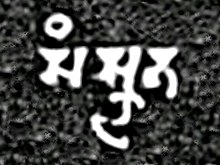
The earliest known use of the word Saṃskṛta (Sanskrit), in the context of a speech or language, is found in verses 5.28.17–19 of the Ramayana. Outside the learned sphere of written Classical Sanskrit, vernacular colloquial dialects (Prakrits)
continued to evolve. Sanskrit co-existed with numerous other Prakrit
languages of ancient India. The Prakrit languages of India also have
ancient roots and some Sanskrit scholars have called these Apabhramsa, literally "spoiled". The Vedic literature includes words whose phonetic equivalent are not found in other Indo-European languages
but which are found in the regional Prakrit languages, which makes it
likely that the interaction, the sharing of words and ideas began early
in the Indian history. As the Indian thought diversified and challenged
earlier beliefs of Hinduism, particularly in the form of Buddhism and Jainism, the Prakrit languages such as Pali in Theravada Buddhism and Ardhamagadhi in Jainism competed with Sanskrit in the ancient times. However, states Paul Dundas,
a scholar of Jainism, these ancient Prakrit languages had "roughly the
same relationship to Sanskrit as medieval Italian does to Latin." The Indian tradition states that the Buddha and the Mahavira
preferred the Prakrit language so that everyone could understand it.
However, scholars such as Dundas have questioned this hypothesis. They
state that there is no evidence for this and whatever evidence is
available suggests that by the start of the common era, hardly anybody
other than learned monks had the capacity to understand the old Prakrit
languages such as Ardhamagadhi.
Colonial era scholars questioned whether Sanskrit was ever a spoken language, or just a literary language.
Scholars disagree in their answers. A section of Western scholars state
that Sanskrit was never a spoken language, while others and
particularly most Indian scholars state the opposite.
Those who affirm Sanskrit to have been a vernacular language point to
the necessity of Sanskrit being a spoken language for the oral tradition
that preserved the vast number of Sanskrit manuscripts from ancient
India. Secondly, they state that the textual evidence in the works of
Yaksa, Panini and Patanajali affirms that the Classical Sanskrit in
their era was a language that is spoken (bhasha) by the cultured and educated. Some sutras expound upon the variant forms of spoken Sanskrit versus written Sanskrit. The 7th-century Chinese Buddhist pilgrim Xuanzang
mentioned in his memoir that official philosophical debates in India
were held in Sanskrit, not in the vernacular language of that region.
According to Sanskrit linguist Madhav
According to Sanskrit linguist Madhav Deshpande,
Sanskrit was a spoken language in a colloquial form by the mid-1st
millennium BCE which coexisted with a more formal, grammatically correct
form of literary Sanskrit.[119]
This, states Deshpande, is true for modern languages where colloquial
incorrect approximations and dialects of a language are spoken and
understood, along with more "refined, sophisticated and grammatically
accurate" forms of the same language being found in the literary works.[119] The Indian tradition, states Moriz Winternitz,
has favored the learning and the usage of multiple languages from the
ancient times. Sanskrit was a spoken language in the educated and the
elite classes, but it was also a language that must have been understood
in a wider circle of society because the widely popular folk epics and
stories such as the Ramayana, the Mahabharata, the Bhagavata Purana, the Panchatantra and many other texts are all in the Sanskrit language.[120]
The Classical Sanskrit with its exacting grammar was thus the language
of the Indian scholars and the educated classes, while others
communicated with approximate or ungrammatical variants of it as well as
other natural Indian languages.[119] Sanskrit, as the learned language of Ancient India, thus existed alongside the vernacular Prakrits.[119] Many Sanskrit dramas indicate that the language coexisted with the vernacular Prakrits. Centres in Varanasi, Paithan, Pune and Kanchipuram were centers of classical Sanskrit learning and public debates until the arrival of the colonial era.[121]
According to Étienne Lamotte,
an Indologist and Buddhism scholar, Sanskrit became the dominant
literary and inscriptional language because of its precision in
communication. It was, states Lamotte, an ideal instrument for
presenting ideas, and as knowledge in Sanskrit multiplied, so did its
spread and influence.[122]
Sanskrit was adopted voluntarily as a vehicle of high culture, arts,
and profound ideas. Pollock disagrees with Lamotte, but concurs that
Sanskrit's influence grew into what he terms a "Sanskrit Cosmopolis"
over a region that included all of South Asia and much of southeast
Asia. The Sanskrit language cosmopolis thrived beyond India between 300
and 1300 CE.[123]
Proto-Dravidian influence on Sanskrit
Reinöhl
mentions that not only have the Dravidian languages borrowed from
Sanskrit vocabulary but they have also impacted Sanskrit on deeper
levels of structure “for instance in the domain of phonology where
Indo-Aryan retroflexes have been attributed to Dravidian Influence”.[124] Hans Henrich et al. quoting George Hart state that, there was influence of Old Tamil on Sanskrit.[125]Hart
compared Old Tamil and Classical Sanskrit to arrive at a conclusion
that there was a common language Prakrit from which both derived – “that
both Tamil and Sanskrit derived their shared conventions, metres, and
techniques from a common source, for it is clear that neither borrowed
directly from the other.”.[126]
Reinöhl further states that there is a symmetric relationship
between Dravidian language like Kannada or Tamil with Indo-Aryan
language like Bengali or Hindi whereas the same is not found in Persian
or English sentence into Non-Indo Aryan language. To quote from Reinöhl –
“A sentence in a Dravidian language like Tamil or Kannada becomes
ordinarily good Bengali or Hindi by substituting Bengali or Hindi
equivalents for the Dravidian words and forms, without modifying the
word order, but the same thing is not possible in rendering a Persian or
English sentence into a non-Indo-Aryan language”.[124]
Shulman mentions that "Dravidian nonfinite verbal forms (called vinaiyeccam
in Tamil) shaped the usage of the Sanskrit nonfinite verbs (originally
derived from inflected forms of action nouns in Vedic). This
particularly salient case of possible influence of Dravidian on Sanskrit
is only one of many items of syntactic assimilation, not least among
them the large repertoire of morphological modality and aspect that,
once one knows to look for it, can be found everywhere in classical and
postclassical Sanskrit".[127]
Influence
Extant manuscripts in
Sanskrit number over 30 million, one hundred times those in Greek and
Latin combined, constituting the largest cultural heritage that any
civilization has produced prior to the invention of the printing press.
— Foreword of Sanskrit Computational Linguistics (2009), Gérard Huet, Amba Kulkarni and Peter Scharf[128][129][h]
Sanskrit has been the predominant language of Hindu texts encompassing a rich tradition of philosophical and religious texts, as well as poetry, music, drama, scientific, technical and others.[131]
It is the predominant language of one of the largest collection of
historic manuscripts. The earliest known inscriptions in Sanskrit are
from the 1st century BCE, such as the Ayodhya Inscription of Dhana and Ghosundi-Hathibada (Chittorgarh).
Though developed and nurtured by scholars of orthodox schools of
Hinduism, Sanskrit has been the language for some of the key literary
works and theology of heterodox schools of Indian philosophies such as
Buddhism and Jainism.[134]
The structure and capabilities of the Classical Sanskrit language
launched ancient Indian speculations about "the nature and function of
language", what is the relationship between words and their meanings in
the context of a community of speakers, whether this relationship is
objective or subjective, discovered or is created, how individuals learn
and relate to the world around them through language, and about the
limits of language?[134][136]
They speculated on the role of language, the ontological status of
painting word-images through sound, and the need for rules so that it
can serve as a means for a community of speakers, separated by geography
or time, to share and understand profound ideas from each other.[136][i] These speculations became particularly important to the Mīmāṃsā and the Nyaya schools of Hindu philosophy, and later to Vedanta and Mahayana Buddhism, states Frits Staal—a scholar of Linguistics with a focus on Indian philosophies and Sanskrit.[134]
Though written in a number of different scripts, the dominant language
of Hindu texts has been Sanskrit. It or a hybrid form of Sanskrit became
the preferred language of Mahayana Buddhism scholarship; for example, one of the early and influential Buddhist philosophers, Nagarjuna (~200 CE), used Classical Sanskrit as the language for his texts.[140]
According to Renou, Sanskrit had a limited role in the Theravada
tradition (formerly known as the Hinayana) but the Prakrit works that
have survived are of doubtful authenticity. Some of the canonical
fragments of the early Buddhist traditions, discovered in the 20th
century, suggest the early Buddhist traditions used an imperfect and
reasonably good Sanskrit, sometimes with a Pali syntax, states Renou.
The Mahāsāṃghika and Mahavastu, in their late Hinayana forms, used hybrid Sanskrit for their literature.
Sanskrit was also the language of some of the oldest surviving,
authoritative and much followed philosophical works of Jainism such as
the Tattvartha Sutra by Umaswati.[142][143]
The
Spitzer Manuscript is dated to about the 2nd century CE (above: folio 383 fragment). Discovered near the northern branch of the Central Asian
Silk Route in northwest
China,
[144] it is the oldest Sanskrit philosophical manuscript known so far.
[145][146]The Sanskrit language has been one of the major means for the
transmission of knowledge and ideas in Asian history. Indian texts in
Sanskrit were already in China by 402 CE, carried by the influential
Buddhist pilgrim Faxian who translated them into Chinese by 418 CE. Xuanzang,
another Chinese Buddhist pilgrim, learnt Sanskrit in India and carried
657 Sanskrit texts to China in the 7th century where he established a
major center of learning and language translation under the patronage of
Emperor Taizong.[148][149] By the early 1st millennium CE, Sanskrit had spread Buddhist and Hindu ideas to Southeast Asia,[150] parts of the East Asia[151] and the Central Asia. It was accepted as a language of high culture and the preferred language by some of the local ruling elites in these regions. According to the Dalai Lama,
the Sanskrit language is a parent language that is at the foundation of
many modern languages of India and the one that promoted Indian thought
to other distant countries. In Tibetan Buddhism, states the Dalai Lama,
Sanskrit language has been a revered one and called legjar lhai-ka or "elegant language of the gods". It has been the means of transmitting the "profound wisdom of Buddhist philosophy" to Tibet.
A 5th-century Sanskrit inscription discovered in Java Indonesia—one of earliest in southeast Asia. The
Ciaruteun inscription combines two writing scripts and compares the king to the Hindu god
Vishnu. It provides a
terminus ad quem to the presence of Hinduism in the Indonesian islands. The oldest southeast Asian Sanskrit inscription—called the
Vo Canh inscription—so far discovered is near
Nha Trang,
Vietnam, and it is dated to the late 2nd century to early 3rd century CE.
[156]The Sanskrit language created a pan-Indo-Aryan accessibility to
information and knowledge in the ancient and medieval times, in contrast
to the Prakrit languages which were understood just regionally.[121] It created a cultural bond across the subcontinent. As local languages and dialects evolved and diversified, Sanskrit served as the common language.
It connected scholars from distant parts of South Asia such as Tamil
Nadu and Kashmir, states Deshpande, as well as those from different
fields of studies, though there must have been differences in its
pronunciation given the first language of the respective speakers. The
Sanskrit language brought Indo-Aryan speaking people together,
particularly its elite scholars.[121]
Some of these scholars of Indian history regionally produced
vernacularized Sanskrit to reach wider audiences, as evidenced by texts
discovered in Rajasthan, Gujarat, and Maharashtra. Once the audience
became familiar with the easier to understand vernacularized version of
Sanskrit, those interested could graduate from colloquial Sanskrit to
the more advanced Classical Sanskrit. Rituals and the rites-of-passage
ceremonies have been and continue to be the other occasions where a wide
spectrum of people hear Sanskrit, and occasionally join in to speak
some Sanskrit words such as "namah".[121]
Classical Sanskrit is the standard register as laid out in the grammar of Pāṇini, around the fourth century BCE.[158] Its position in the cultures of Greater India is akin to that of Latin and Ancient Greek in Europe. Sanskrit has significantly influenced most modern languages of the Indian subcontinent, particularly the languages of the northern, western, central and eastern Indian subcontinent.[159][160][161]
Decline
Sanskrit declined starting about and after the 13th century.[123][162]
This coincides with the beginning of Islamic invasions of South Asia to
create, and thereafter expand the Muslim rule in the form of
Sultanates, and later the Mughal Empire.
With the fall of Kashmir around the 13th century, a premier center of
Sanskrit literary creativity, Sanskrit literature there disappeared,[164]
perhaps in the "fires that periodically engulfed the capital of
Kashmir" or the "Mongol invasion of 1320" states Sheldon Pollock.[165]:397–398
The Sanskrit literature which was once widely disseminated out of the
northwest regions of the subcontinent, stopped after the 12th century.[165]:398 As Hindu kingdoms fell in the eastern and the South India, such as the great Vijayanagara Empire, so did Sanskrit.[164]
There were exceptions and short periods of imperial support for
Sanskrit, mostly concentrated during the reign of the tolerant Mughal
emperor Akbar.[166]
Muslim rulers patronized the Middle Eastern language and scripts found
in Persia and Arabia, and the Indians linguistically adapted to this
Persianization to gain employment with the Muslim rulers.[167] Hindu rulers such as Shivaji of the Maratha Empire, reversed the process, by re-adopting Sanskrit and re-asserting their socio-linguistic identity.[167][168][169]
After Islamic rule disintegrated in South Asia and the colonial rule
era began, Sanskrit re-emerged but in the form of a "ghostly existence"
in regions such as Bengal. This decline was the result of "political
institutions and civic ethos" that did not support the historic Sanskrit
literary culture.[164]
Scholars are divided on whether or when Sanskrit died. Western
authors such as John Snelling state that Sanskrit and Pali are both dead
Indian languages.[170] Indian authors such as M Ramakrishnan Nair state that Sanskrit was a dead language by the 1st millennium BCE.[171] Sheldon Pollock states that in some crucial way, "Sanskrit is dead".[165]:393
After the 12th century, the Sanskrit literary works were reduced to
"reinscription and restatements" of ideas already explored, and any
creativity was restricted to hymns and verses. This contrasted with the
previous 1,500 years when "great experiments in moral and aesthetic
imagination" marked the Indian scholarship using Classical Sanskrit,
states Pollock.[165]:398
Other scholars state that the Sanskrit language did not die, only
declined. Hanneder disagrees with Pollock, finding his arguments
elegant but "often arbitrary". According to Hanneder, a decline or
regional absence of creative and innovative literature constitutes a
negative evidence to Pollock's hypothesis, but it is not positive
evidence. A closer look at Sanskrit in the Indian history after the 12th
century suggests that Sanskrit survived despite the odds. According to
Hanneder,[172]
On a more public level the
statement that Sanskrit is a dead language is misleading, for Sanskrit
is quite obviously not as dead as other dead languages and the fact that
it is spoken, written and read will probably convince most people that
it cannot be a dead language in the most common usage of the term.
Pollock's notion of the "death of Sanskrit" remains in this unclear
realm between academia and public opinion when he says that "most
observers would agree that, in some crucial way, Sanskrit is dead."[164]
Sanskrit language manuscripts exist in many scripts. Above from top: Isha Upanishad (Devanagari), Samaveda (Tamil Grantha), Bhagavad Gita (Gurmukhi), Vedanta Sara (Telugu), Jatakamala (early Sharada). All are Hindu texts except the last Buddhist text.
The Sanskrit language scholar Moriz Winternitz
states, Sanskrit was never a dead language and it is still alive though
its prevalence is lesser than ancient and medieval times. Sanskrit
remains an integral part of Hindu journals, festivals, Ramlila plays,
drama, rituals and the rites-of-passage.[173]
Similarly, Brian Hatcher states that the "metaphors of historical
rupture" by Pollock are not valid, that there is ample proof that
Sanskrit was very much alive in the narrow confines of surviving Hindu
kingdoms between the 13th and 18th centuries, and its reverence and
tradition continues.[174]
Hanneder states that modern works in Sanskrit are either ignored or their "modernity" contested.[175]
According to Robert Goldman and Sally Sutherland, Sanskrit is
neither "dead" nor "living" in the conventional sense. It is a special,
timeless language that lives in the numerous manuscripts, daily chants
and ceremonial recitations, a heritage language that Indians
contextually prize and some practice.[176]
When the British introduced English to India in the 19th century,
knowledge of Sanskrit and ancient literature continued to flourish as
the study of Sanskrit changed from a more traditional style into a form
of analytical and comparative scholarship mirroring that of Europe.[177]
Modern Indo-Aryan languages
The
relationship of Sanskrit to the Prakrit languages, particularly the
modern form of Indian languages, is complex and spans about 3,500 years,
states Colin Masica—a
linguist specializing in South Asian languages. A part of the
difficulty is the lack of sufficient textual, archaeological and
epigraphical evidence for the ancient Prakrit languages with rare
exceptions such as Pali, leading to a tendency of anachronistic errors.
Sanskrit and Prakrit languages may be divided into Old Indo-Aryan (1500
BCE–600 BCE), Middle Indo-Aryan (600 BCE–1000 CE) and New Indo-Aryan
(1000 CE–current), each can further be subdivided in early, middle or
second, and late evolutionary substages.
Vedic Sanskrit belongs to the early Old Indo-Aryan while
Classical Sanskrit to the later Old Indo-Aryan stage. The evidence for
Prakrits such as Pali (Theravada Buddhism) and Ardhamagadhi (Jainism),
along with Magadhi, Maharashtri, Sinhala, Sauraseni and Niya (Gandhari),
emerge in the Middle Indo-Aryan stage in two versions—archaic and more
formalized—that may be placed in early and middle substages of the
600 BCE – 1000 CE period.
Two literary Indo-Aryan languages can be traced to the late Middle
Indo-Aryan stage and these are Apabhramsa and Elu (a form of literary
Sinhalese). Numerous North, Central, Eastern and Western Indian
languages, such as Hindi, Gujarati, Sindhi, Punjabi, Kashmiri, Nepali,
Braj, Awadhi, Bengali, Assamese, Oriya, Marathi, and others belong to
the New Indo-Aryan stage.
There is an extensive overlap in the vocabulary, phonetics and
other aspects of these New Indo-Aryan languages with Sanskrit, but it is
neither universal nor identical across the languages. They likely
emerged from a synthesis of the ancient Sanskrit language traditions and
an admixture of various regional dialects. Each language has some
unique and regionally creative aspects, with unclear origins. Prakrit
languages do have a grammatical structure, but like the Vedic Sanskrit,
it is far less rigorous than Classical Sanskrit. The roots of all
Prakrit languages may be in the Vedic Sanskrit and ultimately the
Indo-Aryan language, their structural details vary from the Classical
Sanskrit.[24] It is generally accepted by scholars and widely believed in India that the modern Indo-Aryan languages, such as Bengali, Gujarati, Hindi and Punjabi are descendants of the Sanskrit language.[180][181] Sanskrit, states Burjor Avari, can be described as "the mother language of almost all the languages of north India".[182]
Geographic distribution
Sanskrit
language's historical presence has been attested in many countries. The
evidence includes manuscript pages and inscriptions discovered in South
Asia, Southeast Asia and Central Asia. These have been dated between
300 and 1800 CE.
The Sanskrit language's historic presence is attested across a wide
geography beyond South Asia. Inscriptions and literary evidence suggests
that Sanskrit language was already being adopted in Southeast Asia and
Central Asia in the 1st millennium CE, through monks, religious pilgrims
and merchants.[183][184]
South Asia has been the geographic range of the largest
collection of the ancient and pre-18th-century Sanskrit manuscripts and
inscriptions.[130]
Beyond ancient India, significant collections of Sanskrit manuscripts
and inscriptions have been found in China (particularly the Tibetan
monasteries),[186][187] Myanmar, Indonesia, Cambodia, Laos, Vietnam, Thailand, and Malaysia.
Sanskrit inscriptions, manuscripts or its remnants, including some of
the oldest known Sanskrit written texts, have been discovered in dry
high deserts and mountainous terrains such as in Nepal,[194][195][j] Tibet,[187] Afghanistan,[197] Mongolia,[199] Uzbekistan, Turkmenistan, Tajikistan, and Kazakhstan.[201] Some Sanskrit texts and inscriptions have also been discovered in Korea and Japan.[202][203]
Official status
In India, Sanskrit is among the 22 official languages of India in the Eighth Schedule to the Constitution.[205] In 2010, Uttarakhand became the first state in India to make Sanskrit its second official language.[206] In 2019, Himachal Pradesh made Sanskrit its second official language, becoming the second state in India to do so.[207]
Phonology
Sanskrit
shares many Proto-Indo-European phonological features, although it
features a larger inventory of distinct phonemes. The consonantal system
is the same, though it systematically enlarged the inventory of
distinct sounds. For example, Sanskrit added a voiceless aspirated "tʰ",
to the voiceless "t", voiced "d" and voiced aspirated "dʰ" found in PIE
languages.
The most significant and distinctive phonological development in
Sanskrit is vowel-merger, states Stephanie Jamison—an Indo-European
linguist specializing in Sanskrit literature. The short *e, *o and *a, all merge as a (अ) in Sanskrit, while long *ē, *ō and *ā, all merge as long ā (आ). These mergers occurred very early and significantly impacted Sanskrit's morphological system.
Some phonological developments in it mirror those in other PIE
languages. For example, the labiovelars merged with the plain velars as
in other satem languages. The secondary palatalization of the resulting
segments is more thorough and systematic within Sanskrit, states
Jamison.
A series of retroflex dental stops were innovated in Sanskrit to more
thoroughly articulate sounds for clarity. For example, unlike the loss
of the morphological clarity from vowel contraction that is found in
early Greek and related southeast European languages, Sanskrit deployed *y, *w, and *s intervocalically to provide morphological clarity.
Vowels
The cardinal vowels (svaras) i (इ), u (उ), a (अ) distinguish length in Sanskrit, states Jamison.[210] The short a
(अ) in Sanskrit is a closer vowel than ā, equivalent to schwa. The
mid-vowels ē (ए) and ō (ओ) in Sanskrit are monophthongizations of the
Indo-Iranian diphthongs *ai and *au. The Old Iranian language preserved *ai and *au. The Sanskrit vowels are inherently long, though often transcribed e and o without the diacritic. The vocalic liquid r̥ in Sanskrit is a merger of PIE *r̥ and *l̥. The long r̥ is an innovation and it is used in a few analogically generated morphological categories.
This
is one of the oldest surviving and dated palm-leaf manuscript in
Sanskrit (828 CE). Discovered in Nepal, the bottom leaf shows all the
vowels and consonants of Sanskrit (the first five consonants are
highlighted in blue and yellow).
Sanskrit vowels in the Devanagari script[213][k]
|
|
Independent form
|
IAST/
ISO
|
IPA
|
|
Independent form
|
IAST/
ISO
|
IPA
|
kaṇṭhya
(Guttural)
|
अ
|
a
|
/ə/
/ɐ/
|
आ
|
ā
|
/aː/
|
tālavya
(Palatal)
|
इ
|
i
|
/ɪ/
|
ई
|
ī
|
/iː/
|
oṣṭhya
(Labial)
|
उ
|
u
|
/ʊ/
|
ऊ
|
ū
|
/uː/
|
mūrdhanya
(Retroflex)
|
ऋ
|
ṛ/r̥
|
/ɽ̩/
|
ॠ
|
ṝ/r̥̄
|
/ɽ̩ː/
|
dantya
(Dental)
|
ऌ
|
ḷ/l̥
|
/l̩/
|
(ॡ)
|
(ḹ/l̥̄)[214]
|
/l̩ː/
|
kaṇṭhatālavya
(Palatoguttural)
|
ए
|
e/ē
|
/eː/
|
ऐ
|
ai
|
/aːi/
|
kaṇṭhoṣṭhya
(Labioguttural)
|
ओ
|
o/ō
|
/oː/
|
औ
|
au
|
/aːu/
|
| (consonantal allophones)
|
अं
|
aṃ/aṁ[215]
|
/ɐ̃/
|
अः
|
aḥ[216]
|
/ɐh/
|
According to Masica, Sanskrit has four traditional semivowels, with
which were classed, "for morphophonemic reasons, the liquids: y, r, l,
and v; that is, as y and v were the non-syllabics corresponding to i, u,
so were r, l in relation to r̥ and l̥".
The northwestern, the central and the eastern Sanskrit dialects have
had a historic confusion between "r" and "l". The Paninian system that
followed the central dialect preserved the distinction, likely out of
reverence for the Vedic Sanskrit that distinguished the "r" and "l".
However, the northwestern dialect only had "r", while the eastern
dialect probably only had "l", states Masica. Thus literary works from
different parts of ancient India appear inconsistent in their use of "r"
and "l", resulting in doublets that is occasionally semantically
differentiated.
Consonants
Sanskrit
possesses a symmetric consonantal phoneme structure based on how the
sound is articulated, though the actual usage of these sounds conceals
the lack of parallelism in the apparent symmetry possibly from
historical changes within the language.
Sanskrit consonants in the Devanagari script[213][l]
|
sparśa
(Plosive)
|
anunāsika
(Nasal)
|
antastha
(Approximant)
|
ūṣman/saṃgharṣhī
(Fricative)
|
| Voicing →
|
aghoṣa
|
ghoṣa
|
aghoṣa
|
| Aspiration →
|
alpaprāṇa
|
mahāprāṇa
|
alpaprāṇa
|
mahāprāṇa
|
alpaprāṇa
|
mahāprāṇa
|
kaṇṭhya
(Guttural)
|
क |
ka
|
/k/
|
ख |
kha
|
/kʰ/
|
ग |
ga
|
/g/
|
घ |
gha
|
/gʱ/
|
ङ |
ṅa
|
/ŋ/
|
ह |
ha
|
/ɦ/
|
|
|
|
tālavya
(Palatal)
|
च |
ca
|
/c/
/t͡ɕ/
|
छ |
cha
|
/cʰ/
/t͡ɕʰ/
|
ज |
ja
|
/ɟ/
/d͡ʑ/
|
झ |
jha
|
/ɟʱ/
/d͡ʑʱ/
|
ञ |
ña
|
/ɲ/
|
य |
ya
|
/j/
|
श |
śa
|
/ɕ/
|
mūrdhanya
(Retroflex)
|
ट |
ṭa
|
/ʈ/
|
ठ |
ṭha
|
/ʈʰ/
|
ड |
ḍa
|
/ɖ/
|
ढ |
ḍha
|
/ɖʱ/
|
ण |
ṇa
|
/ɳ/
|
र |
ra
|
/ɽ/
|
ष |
ṣa
|
/ʂ/
|
dantya
(Dental)
|
त |
ta
|
/t/
|
थ |
tha
|
/tʰ/
|
द |
da
|
/d/
|
ध |
dha
|
/dʱ/
|
न |
na
|
/n/
|
ल |
la
|
/l/
|
स |
sa
|
/s/
|
oṣṭhya
(Labial)
|
प |
pa
|
/p/
|
फ |
pha
|
/pʰ/
|
ब |
ba
|
/b/
|
भ |
bha
|
/bʱ/
|
म |
ma
|
/m/
|
व |
va
|
/ʋ/
|
|
|
|
Sanskrit had a series of retroflex stops. All the retroflexes in
Sanskrit are in "origin conditioned alternants of dentals, though from
the beginning of the language they have a qualified independence",
states Jamison.
Regarding the palatal plosives, the pronunciation is a matter of
debate. In contemporary attestation, the palatal plosives are a regular
series of palatal stops, supported by most Sanskrit sandhi rules.
However, the reflexes in descendant languages, as well as a few of the
sandhi rules regarding ch, could suggest an affricate pronunciation.
jh was a marginal phoneme in Sanskrit, hence its phonology
is more difficult to reconstruct; it was more commonly employed in the
Middle Indo-Aryan languages as a result of phonological processes
resulting in the phoneme.
The palatal nasal is a conditioned variant of n occurring next to palatal obstruents. The anusvara that Sanskrit deploys is a conditioned alternant of postvocalic nasals, under certain sandhi conditions. Its visarga is a word-final or morpheme-final conditioned alternant of s and r under certain sandhi conditions.
The system of Sanskrit Sounds
[The]
order of Sanskrit sounds works along three principles: it goes from
simple to complex; it goes from the back to the front of the mouth; and
it groups similar sounds together. [...] Among themselves, both the
vowels and consonants are ordered according to where in the mouth they
are pronounced, going from back to front.
— A. M. Ruppel, The Cambridge Introduction to Sanskrit
The voiceless aspirated series is also an innovation in Sanskrit but is significantly rarer than the other three series.
While the Sanskrit language organizes sounds for expression
beyond those found in the PIE language, it retained many features found
in the Iranian and Balto-Slavic languages. An example of a similar
process in all three, states Jamison, is the retroflex sibilant ʂ being
the automatic product of dental s following i, u, r, and k (mnemonically
"ruki").
Phonological alternations, sandhi rules
Sanskrit deploys extensive phonological alternations on different linguistic levels through sandhi
rules (literally, the rules of "putting together, union, connection,
alliance"). This is similar to the English alteration of "going to" as gonna, states Jamison. The Sanskrit language accepts such alterations within it, but offers formal rules for the sandhi of any two words next to each other in the same sentence or linking two sentences. The external sandhi
rules state that similar short vowels coalesce into a single long
vowel, while dissimilar vowels form glides or undergo diphthongization. Among the consonants, most external sandhi
rules recommend regressive assimilation for clarity when they are
voiced. According to Jamison, these rules ordinarily apply at compound
seams and morpheme boundaries. In Vedic Sanskrit, the external sandhi rules are more variable than in Classical Sanskrit.
The internal sandhi rules are more intricate and account
for the root and the canonical structure of the Sanskrit word. These
rules anticipate what are now known as the Bartholomae's law and Grassmann's law.
For example, states Jamison, the "voiceless, voiced, and voiced
aspirated obstruents of a positional series regularly alternate with
each other (p ≈ b ≈ bʰ; t ≈ d ≈ dʰ, etc.; note, however, c ≈ j ≈ h),
such that, for example, a morpheme with an underlying voiced aspirate
final may show alternants[clarification needed] with all three stops under differing internal sandhi conditions".
The velar series (k, g, gʰ) alternate with the palatal series (c, j,
h), while the structural position of the palatal series is modified into
a retroflex cluster when followed by dental. This rule create two
morphophonemically distinct series from a single palatal series.
Vocalic alternations in the Sanskrit morphological system is termed "strengthening", and called guna and vriddhi
in the preconsonantal versions. There is an equivalence to terms
deployed in Indo-European descriptive grammars, wherein Sanskrit's
unstrengthened state is same as the zero-grade, guna corresponds to normal-grade, while vriddhi is same as the lengthened-state.
The qualitative ablaut is not found in Sanskrit just like it is absent
in Iranian, but Sanskrit retains quantitative ablaut through vowel
strengthening. The transformations between unstrengthened to guna is prominent in the morphological system, states Jamison, while vriddhi
is a particularly significant rule when adjectives of origin and
appurtenance are derived. The manner in which this is done slightly
differs between the Vedic and the Classical Sanskrit.
|
A recitation of the Sanskrit composition Guru Stotram, or "the hymn of praise for the teacher (guru)". (4 mins, 55 secs) |
Problems playing this file? See media help. |
Sanskrit grants a very flexible syllable structure, where they may
begin or end with vowels, be single consonants or clusters. Similarly,
the syllable may have an internal vowel of any weight. The Vedic
Sanskrit shows traces of following the Sievers-Edgerton Law, but
Classical Sanskrit doesn't. Vedic Sanskrit has a pitch accent system,
states Jamison, which were acknowledged by Panini, but in his Classical
Sanskrit the accents disappear. Most Vedic Sanskrit words have one accent. However, this accent is not phonologically predictable, states Jamison. It can fall anywhere in the word and its position often conveys morphological and syntactic information.
According to Masica, the presence of an accent system in Vedic Sanskrit
is evidenced from the markings in the Vedic texts. This is important
because of Sanskrit's connection to the PIE languages and comparative
Indo-European linguistics.
Sanskrit, like most early Indo-European languages, lost the so-called "laryngeal consonants (cover-symbol *H) present in the Proto-Indo-European", states Jamison.
This significantly impacted the evolutionary path of the Sanskrit
phonology and morphology, particularly in the variant forms of roots.
Pronunciation
Because
Sanskrit is not anyone's native language, it does not have a fixed
pronunciation. People tend to pronounce it as they do their native
language. The articles on Hindustani, Marathi, Nepali, Oriya and Bengali phonology
will give some indication of the variation that is encountered. When
Sanskrit was a spoken language, its pronunciation varied regionally and
also over time. Nonetheless, Panini described the sound system of
Sanskrit well enough that people have a fairly good idea of what he
intended.
Various renditions of Sanskrit pronunciation
| Transcription |
|
Goldman
(2002)[229]
|
Cardona
(2003)[230]
|
| a
|
ɐ
|
ɐ
|
| ā
|
aː
|
aː
|
| i
|
ɪ
|
ɪ
|
| ī
|
iː
|
iː
|
| u
|
ʊ
|
ʊ
|
| ū
|
uː
|
uː
|
| r̥
|
ɽɪ
|
ɽɪ
|
ᵊɾᵊ or ᵊɽᵊ[231]
|
| r̥̄
|
ɽiː
|
ɽiː?[232]
|
?[232]
|
| l̥
|
lɪ
|
?[233]
|
[234]
|
| ē
|
eː
|
eː
|
eː
|
| ai
|
ai
|
ai
|
ɐi or ɛi
|
| ō
|
oː
|
oː
|
oː
|
| au
|
au
|
au
|
ɐu or ɔu
|
| aṃ
|
ɐ̃, ɐN
|
ɐ̃, ɐN[235]
|
| aḥ
|
ɐh
|
ɐhɐ[236]
|
ɐh
|
| k
|
k
|
k
|
| kh
|
kʰ
|
kʰ
|
| g
|
ɡ
|
ɡ
|
| gh
|
ɡʱ
|
ɡʱ
|
| ṅ
|
ŋ
|
ŋ
|
| h
|
ɦ
|
ɦ
|
ɦ
|
| c
|
t͡ɕ
|
t͡ɕ
|
| ch
|
t͡ɕʰ
|
t͡ɕʰ
|
| j
|
d͡ʑ
|
d͡ʑ
|
| jh
|
d͡ʑʱ
|
d͡ʑʱ
|
| ñ
|
n
|
n
|
| y
|
j
|
j
|
j
|
| ś
|
ɕ
|
ɕ
|
ɕ
|
| ṭ
|
t̠
|
t̠
|
| ṭh
|
t̠ʰ
|
t̠ʰ
|
| ḍ
|
d̠
|
d̠
|
| ḍh
|
d̠ʱ
|
d̠ʱ
|
| ṇ
|
n̠
|
n̠
|
| r
|
ɽ
|
ɾ̪, ɾ or ɽ
|
| ṣ
|
s̠
|
s̠
|
ʂ
|
| t
|
t̪
|
t̪
|
| th
|
t̪ʰ
|
t̪ʰ
|
| d
|
d̪
|
d̪
|
| dh
|
d̪ʱ
|
d̪ʱ
|
| n
|
n̪
|
n̪
|
| l
|
l
|
l
|
l̪
|
| s
|
s
|
s
|
s̪
|
| p
|
p
|
p
|
| ph
|
pʰ
|
pʰ
|
| b
|
b
|
b
|
| bh
|
bʱ
|
bʱ
|
| m
|
m
|
m
|
| v
|
ʋ
|
ʋ
|
ʋ
|
| stress
|
|
(ante)pen-
ultimate[237]
|
Morphology
The basis of Sanskrit morphology is the root, states Jamison, "a morpheme bearing lexical meaning".
The verbal and nominal stems of Sanskrit words are derived from this
root through the phonological vowel-gradation processes, the addition of
affixes, verbal and nominal stems. It then adds an ending to establish
the grammatical and syntactic identity of the stem. According to
Jamison, the "three major formal elements of the morphology are (i)
root, (ii) affix, and (iii) ending; and they are roughly responsible for
(i) lexical meaning, (ii) derivation, and (iii) inflection
respectively".
A Sanskrit word has the following canonical structure:
- Root + Affix
0-n + Ending
0–1
The root structure has certain phonological constraints. Two of the
most important constraints of a "root" is that it does not end in a
short "a" (अ) and that it is monosyllabic.
In contrast, the affixes and endings commonly do. The affixes in
Sanskrit are almost always suffixes, with exceptions such as the augment
"a-" added as prefix to past tense verb forms and the "-na/n-" infix in
single verbal present class, states Jamison.
A verb in Sanskrit has the following canonical structure:
- Root + Suffix
Tense-Aspect + Suffix
Mood + Ending
Personal-Number-Voice
According to Ruppel, verbs in Sanskrit express the same information as other Indo-European languages such as English.
Sanskrit verbs describe an action or occurrence or state, its embedded
morphology informs as to "who is doing it" (person or persons), "when it
is done" (tense) and "how it is done" (mood, voice). The Indo-European
languages differ in the detail. For example, the Sanskrit language
attaches the affixes and ending to the verb root, while the English
language adds small independent words before the verb. In Sanskrit,
these elements co-exist within the word.[m]
Word morphology in Sanskrit, A. M. Ruppel[n]
|
Sanskrit word equivalent
|
| English expression
|
IAST/ISO
|
Devanagari
|
| you carry
|
bharasi
|
भरसि
|
| they carry
|
bharanti
|
भरन्ति
|
| you will carry
|
bhariṣyasi
|
भरिष्यसि
|
Both verbs and nouns in Sanskrit are either thematic or athematic, states Jamison. Guna
(strengthened) forms in the active singular regularly alternate in
athematic verbs. The finite verbs of Classical Sanskrit have the
following grammatical categories: person, number, voice, tense-aspect,
and mood. According to Jamison, a portmanteau morpheme generally
expresses the person-number-voice in Sanskrit, and sometimes also the
ending or only the ending. The mood of the word is embedded in the
affix.
These elements of word architecture are the typical building
blocks in Classical Sanskrit, but in Vedic Sanskrit these elements
fluctuate and are unclear. For example, in the Rigveda preverbs regularly occur in tmesis, states Jamison, which means they are "separated from the finite verb".
This indecisiveness is likely linked to Vedic Sanskrit's attempt to
incorporate accent. With nonfinite forms of the verb and with nominal
derivatives thereof, states Jamison, "preverbs show much clearer
univerbation in Vedic, both by position and by accent, and by Classical
Sanskrit, tmesis is no longer possible even with finite forms".
While roots are typical in Sanskrit, some words do not follow the canonical structure.
A few forms lack both inflection and root. Many words are inflected
(and can enter into derivation) but lack a recognizable root. Examples
from the basic vocabulary include kinship terms such as mātar- (mother), nas- (nose), śvan-
(dog). According to Jamison, pronouns and some words outside the
semantic categories also lack roots, as do the numerals. Similarly, the
Sanskrit language is flexible enough to not mandate inflection.
The Sanskrit words can contain more than one affix that interact
with each other. Affixes in Sanskrit can be athematic as well as
thematic, according to Jamison.
Athematic affixes can be alternating. Sanskrit deploys eight cases,
namely nominative, accusative, instrumental, dative, ablative, genitive,
locative, vocative.
Stems, that is "root + affix", appear in two categories in
Sanskrit: vowel stems and consonant stems. Unlike some Indo-European
languages such as Latin or Greek, according to Jamison, "Sanskrit has no
closed set of conventionally denoted noun declensions". Sanskrit
includes a fairly large set of stem-types.
The linguistic interaction of the roots, the phonological segments,
lexical items and the grammar for the Classical Sanskrit consist of four
Paninian components. These, states Paul Kiparsky, are the Astadhyaayi, a comprehensive system of 4,000 grammatical rules, of which a small set are frequently used; Sivasutras, an inventory of anubandhas (markers) that partition phonological segments for efficient abbreviations through the pratyharas technique; Dhatupatha,
a list of 2,000 verbal roots classified by their morphology and
syntactic properties using diacritic markers, a structure that guides
its writing systems; and, the Ganapatha, an inventory of word groups, classes of lexical systems.[247] There are peripheral adjuncts to these four, such as the Unadisutras, which focus on irregularly formed derivatives from the roots.[247]
Sanskrit morphology is generally studied in two broad fundamental
categories: the nominal forms and the verbal forms. These differ in the
types of endings and what these endings mark in the grammatical
context.
Pronouns and nouns share the same grammatical categories, though they
may differ in inflection. Verb-based adjectives and participles are not
formally distinct from nouns. Adverbs are typically frozen case forms of
adjectives, states Jamison, and "nonfinite verbal forms such as
infinitives and gerunds also clearly show frozen nominal case endings".
Tense and voice
The Sanskrit language includes five tenses: present, future, past imperfect, past aorist and past perfect. It outlines three types of voices: active, passive and the middle. The middle is also referred to as the mediopassive, or more formally in Sanskrit as parasmaipada (word for another) and atmanepada (word for oneself).
Voice in Sanskrit, Stephanie Jamison[o]
|
Active
|
Middle
(Mediopassive)
|
| Person
|
Singular
|
Dual
|
Plural
|
Singular
|
Dual
|
Plural
|
| 1st
|
-mi
|
-vas
|
-mas
|
-e
|
-vahe
|
-mahe
|
| 2nd
|
-si
|
-thas
|
-tha
|
-se
|
-āthe
|
-dhve
|
| 3rd
|
-ti
|
-tas
|
-anti
|
-te
|
-āte
|
-ante
|
The paradigm for the tense-aspect system in Sanskrit is the three-way
contrast between the "present", the "aorist" and the "perfect"
architecture. Vedic Sanskrit is more elaborate and had several additional tenses. For example, the Rigveda
includes perfect and a marginal pluperfect. Classical Sanskrit
simplifies the "present" system down to two tenses, the perfect and the
imperfect, while the "aorist" stems retain the aorist tense and the
"perfect" stems retain the perfect and marginal pluperfect.
The classical version of the language has elaborate rules for both
voice and the tense-aspect system to emphasize clarity, and this is more
elaborate than in other Indo-European languages. The evolution of these
systems can be seen from the earliest layers of the Vedic literature to
the late Vedic literature.
Gender, mood
Sanskrit recognizes three numbers—singular, dual, and plural.
The dual is a fully functioning category, used beyond naturally paired
objects such as hands or eyes, extending to any collection of two. The
elliptical dual is notable in the Vedic Sanskrit, according to Jamison,
where a noun in the dual signals a paired opposition. Illustrations include dyāvā (literally, "the two heavens" for heaven-and-earth), mātarā (literally, "the two mothers" for mother-and-father).
A verb may be singular, dual or plural, while the person recognized in
the language are forms of "I", "you", "he/she/it", "we" and "they".
There are three persons in Sanskrit: first, second and third.
Sanskrit uses the 3×3 grid formed by the three numbers and the three
persons parameters as the paradigm and the basic building block of its
verbal system.
The Sanskrit language incorporates three genders: feminine, masculine and neuter.
All nouns have inherent gender, but with some exceptions, personal
pronouns have no gender. Exceptions include demonstrative and anaphoric
pronouns. Derivation of a word is used to express the feminine. Two most common derivations come from feminine-forming suffixes, the -ā- (आ, Rādhā) and -ī- (ई, Rukmīnī). The masculine and neuter are much simpler, and the difference between them is primarily inflectional.[250]
Similar affixes for the feminine are found in many Indo-European
languages, states Burrow, suggesting links of the Sanskrit to its PIE
heritage.
Pronouns in Sanskrit include the personal pronouns of the first
and second persons, unmarked for gender, and a larger number of
gender-distinguishing pronouns and adjectives. Examples of the former include ahám (first singular), vayám (first plural) and yūyám (second plural). The latter can be demonstrative, deictic or anaphoric. Both the Vedic and Classical Sanskrit share the sá/tám
pronominal stem, and this is the closest element to a third person
pronoun and an article in the Sanskrit language, states Jamison.
Indicative, potential and imperative are the three mood forms in Sanskrit.
Prosody, meter
The Sanskrit language formally incorporates poetic metres.[252]
By the late Vedic era, this developed into a field of study and it was
central to the composition of the Hindu literature including the later
Vedic texts. This study of Sanskrit prosody is called chandas and considered as one of the six Vedangas, or limbs of Vedic studies.[252][253]
Sanskrit prosody includes linear and non-linear systems.
The system started off with seven major metres, according to Annette
Wilke and Oliver Moebus, called the "seven birds" or "seven mouths of
Brihaspati", and each had its own rhythm, movements and aesthetics
wherein a non-linear structure (aperiodicity) was mapped into a four
verse polymorphic linear sequence. A syllable in Sanskrit is classified as either laghu (light) or guru (heavy). This classification is based on a matra
(literally, "count, measure, duration"), and typically a syllable that
ends in a short vowel is a light syllable, while those that end in
consonant, anusvara or visarga are heavy. The classical Sanskrit found in Hindu scriptures such as the Bhagavad Gita and many texts are so arranged that the light and heavy syllables in them follow a rhythm, though not necessarily a rhyme.[256][257][p]
Sanskrit metres include those based on a fixed number of syllables per verse, and those based on fixed number of morae per verse.[259]
The Vedic Sanskrit employs fifteen metres, of which seven are common,
and the most frequent are three (8-, 11- and 12-syllable lines).[260]
The Classical Sanskrit deploys both linear and non-linear metres, many
of which are based on syllables and others based on diligently crafted
verses based on repeating numbers of morae (matra per foot).[260]
There is no word without meter,
nor is there any meter without words.
—Natya Shastra[261]
Meter and rhythm is an important part of the Sanskrit language. It
may have played a role in helping preserve the integrity of the message
and Sanskrit texts. The verse perfection in the Vedic texts such as the
verse Upanishads[q]
and post-Vedic Smriti texts are rich in prosody. This feature of the
Sanskrit language led some Indologists from the 19th century onwards to
identify suspected portions of texts where a line or sections are off
the expected metre.[262][263][r]
The meter-feature of the Sanskrit language embeds another layer
of communication to the listener or reader. A change in metres has been a
tool of literary architecture and an embedded code to inform the
reciter and audience that it marks the end of a section or chapter.[267]
Each section or chapter of these texts uses identical metres,
rhythmically presenting their ideas and making it easier to remember,
recall and check for accuracy.[267] Authors coded a hymn's end by frequently using a verse of a metre different than that used in the hymn's body.[267]
However, Hindu tradition does not use the Gayatri metre to end a hymn
or composition, possibly because it has enjoyed a special level of
reverence in Hinduism.[267]
Writing system
One of the oldest surviving Sanskrit manuscript pages in Gupta script (~828 CE), discovered in
NepalThe early history of writing Sanskrit and other languages in ancient
India is a problematic topic despite a century of scholarship, states Richard Salomon—an epigraphist and Indologist specializing in Sanskrit and Pali literature. The earliest possible script from South Asia is from the Indus Valley Civilization
(3rd/2nd millennium BCE), but this script – if it is a script – remains
undeciphered. If any scripts existed in the Vedic period, they have not
survived. Scholars generally accept that Sanskrit was spoken in an oral
society, and that an oral tradition preserved the extensive Vedic and Classical Sanskrit literature.
Other scholars such as Jack Goody state that the Vedic Sanskrit texts
are not the product of an oral society, basing this view by comparing
inconsistencies in the transmitted versions of literature from various
oral societies such as the Greek, Serbian, and other cultures, then
noting that the Vedic literature is too consistent and vast to have been
composed and transmitted orally across generations, without being
written down.[270][271]
Lipi
is the term in Sanskrit which means "writing, letters, alphabet". It
contextually refers to scripts, the art or any manner of writing or
drawing. The term, in the sense of a writing system, appears in some of the earliest Buddhist, Hindu, and Jaina texts. Pāṇini's Astadhyayi, composed sometime around the 5th or 4th century BCE, for example, mentions lipi in the context of a writing script and education system in his times, but he does not name the script.[96][272] Several early Buddhist and Jaina texts, such as the Lalitavistara Sūtra and Pannavana Sutta include lists of numerous writing scripts in ancient India.[s] The Buddhist texts list the sixty four lipi
that the Buddha knew as a child, with the Brahmi script topping the
list. "The historical value of this list is however limited by several
factors", states Salomon. The list may be a later interpolation.[t] The Jain canonical texts such as the Pannavana Sutta—probably
older than the Buddhist texts—list eighteen writing systems, with the
Brahmi topping the list and Kharotthi (Kharoshthi) listed as fourth. The
Jaina text elsewhere states that the "Brahmi is written in 18 different
forms", but the details are lacking.
However, the reliability of these lists has been questioned and the
empirical evidence of writing systems in the form of Sanskrit or Prakrit
inscriptions dated prior to the 3rd century BCE has not been found. If
the ancient surface for writing Sanskrit was palm leaves, tree bark and
cloth—the same as those in later times, these have not survived.[u]
According to Salomon, many find it difficult to explain the "evidently
high level of political organization and cultural complexity" of ancient
India without a writing system for Sanskrit and other languages.[v]
The oldest datable writing systems for Sanskrit are the Brāhmī script, the related Kharoṣṭhī script and the Brahmi derivatives.
The Kharosthi was used in the northwestern part of South Asia and it
became extinct, while the Brahmi was used in all over the subcontinent
along with regional scripts such as Old Tamil.
Of these, the earliest records in the Sanskrit language are in Brahmi, a
script that later evolved into numerous related Indic scripts for
Sanskrit, along with Southeast Asian scripts (Burmese, Thai, Lao, Khmer,
others) and many extinct Central Asian scripts such as those discovered
along with the Kharosthi in the Tarim Basin of western China and in Uzbekistan.
The most extensive inscriptions that have survived into the modern era
are the rock edicts and pillar inscriptions of the 3rd-century BCE
Mauryan emperor Ashoka, but these are not in Sanskrit.[w]
Scripts
Over the centuries, and across countries, a number of scripts have been used to write Sanskrit.
Brahmi script
One of the oldest Hindu Sanskrit
[x] inscriptions, the broken pieces of this early-1st-century BCE
Hathibada Brahmi Inscription were discovered in Rajasthan. It is a dedication to deities Vasudeva-Samkarshana (
Krishna-Balarama) and mentions a stone temple.
[285]The Brahmi script for writing Sanskrit is a "modified
consonant-syllabic" script. The graphic syllable is its basic unit, and
this consists of a consonant with or without diacritic modifications.
Since the vowel is an integral part of the consonants, and given the
efficiently compacted, fused consonant cluster morphology for Sanskrit
words and grammar, the Brahmi and its derivative writing systems deploy
ligatures, diacritics and relative positioning of the vowel to inform
the reader how the vowel is related to the consonant and how it is
expected to be pronounced for clarity.[y]
This feature of Brahmi and its modern Indic script derivatives makes it
difficult to classify it under the main script types used for the
writing systems for most of the world's languages, namely logographic,
syllabic and alphabetic.
The Brahmi script evolved into "a vast number of forms and
derivatives", states Richard Salomon, and in theory, Sanskrit "can be
represented in virtually any of the main Brahmi-based scripts and in
practice it often is".
Sanskrit does not have a native script. Being a phonetic language, it
can be written in any precise script that efficiently maps unique human
sounds to unique symbols.[clarification needed]
From the ancient times, it has been written in numerous regional
scripts in South and Southeast Asia. Most of these are descendants of
the Brahmi script.[289] The earliest datable varnamala Brahmi alphabet system, found in later Sanskrit texts, is from the 2nd century BCE, in the form of a terracotta plaque found in Sughana, Haryana. It shows a "schoolboy's writing lessons", states Salomon.[291]
Nagari script
Many modern era manuscripts are written and available in the Nagari script, whose form is attestable to the 1st millennium CE. The Nagari script is the ancestor of Devanagari (north India), Nandinagari
(south India) and other variants. The Nāgarī script was in regular use
by 7th century CE, and had fully evolved into Devanagari and Nandinagari[293] scripts by about the end of the first millennium of the common era.[294][295] The Devanagari script, states Banerji, became more popular for Sanskrit in India since about the 18th century.[296] However, Sanskrit does have special historical connection to the Nagari script as attested by the epigraphical evidence.
Sanskrit in modern Indian and other Brahmi scripts:
May Śiva bless those who take delight in the language of the gods. (
Kālidāsa)
The Nagari script has been thought as a north Indian script for
Sanskrit as well as the regional languages such as Hindi, Marathi and
Nepali. However, it has had a "supra-local" status as evidenced by
1st-millennium CE epigraphy and manuscripts discovered all over India
and as far as Sri Lanka, Burma, Indonesia and in its parent form called
the Siddhamatrka script found in manuscripts of East Asia. The Sanskrit and Balinese languages Sanur inscription on Belanjong pillar of Bali (Indonesia), dated to about 914 CE, is in part in the Nagari script.[299]
The Nagari script used for Classical Sanskrit has the fullest
repertoire of characters consisting of fourteen vowels and thirty three
consonants. For the Vedic Sanskrit, it has two more allophonic
consonantal characters (the intervocalic ळ ḷa, and ळ्ह ḷha). To communicate phonetic accuracy, it also includes several modifiers such as the anusvara dot and the visarga double dot, punctuation symbols and others such as the halanta sign.
Other writing systems
Other scripts such as Gujarati, Bangla, Odia
and major south Indian scripts, states Salomon, "have been and often
still are used in their proper territories for writing Sanskrit".
These and many Indian scripts look different to the untrained eye, but
the differences between Indic scripts is "mostly superficial and they
share the same phonetic repertoire and systemic features", states
Salomon.
They all have essentially the same set of eleven to fourteen vowels and
thirty-three consonants as established by the Sanskrit language and
attestable in the Brahmi script. Further, a closer examination reveals
that they all have the similar basic graphic principles, the same varnamala
(literally, "garland of letters") alphabetic ordering following the
same logical phonetic order, easing the work of historic skilled scribes
writing or reproducing Sanskrit works across South Asia.[z]
The Sanskrit language written in some Indic scripts exaggerate angles
or round shapes, but this serves only to mask the underlying
similarities. Nagari script favours symmetry set with squared outlines
and right angles. In contrast, Sanskrit written in the Bangla script
emphasizes the acute angles while the neighbouring Odia script
emphasizes rounded shapes and uses cosmetically appealing "umbrella-like
curves" above the script symbols.
One of the earliest known Sanskrit inscriptions in Tamil Grantha script at a rock-cut Hindu Trimurti temple (
Mandakapattu, c. 615 CE)
In the south, where Dravidian languages predominate, scripts used for Sanskrit include the Kannada, Telugu, Malayalam and Grantha alphabets.
Transliteration schemes, Romanisation
Since the late 18th century, Sanskrit has been transliterated using the Latin alphabet. The system most commonly used today is the IAST (International Alphabet of Sanskrit Transliteration), which has been the academic standard since 1888. ASCII-based
transliteration schemes have also evolved because of difficulties
representing Sanskrit characters in computer systems. These include Harvard-Kyoto and ITRANS,
a transliteration scheme that is used widely on the Internet,
especially in Usenet and in email, for considerations of speed of entry
as well as rendering issues. With the wide availability of Unicode-aware web browsers, IAST has become common online. It is also possible to type using an alphanumeric keyboard and transliterate to Devanagari using software like Mac OS X's international support.
European scholars in the 19th century generally preferred
Devanagari for the transcription and reproduction of whole texts and
lengthy excerpts. However, references to individual words and names in
texts composed in European Languages were usually represented with Roman
transliteration. From the 20th century onwards, because of production
costs, textual editions edited by Western scholars have mostly been in Romanised transliteration.[306]
Epigraphy
The earliest known stone inscriptions in Sanskrit are in the Brahmi script from the first century BCE.[aa][ab] These include the Ayodhyā (Uttar Pradesh) and Hāthībādā-Ghosuṇḍī (near Chittorgarh, Rajasthan) inscriptions.[309]
Both of these, states Salomon, are "essentially standard" and "correct
Sanskrit", with a few exceptions reflecting an "informal Sanskrit
usage".
Other important Hindu inscriptions dated to the 1st century BCE, in
relatively accurate classical Sanskrit and Brahmi script are the Yavanarajya inscription on a red sandstone slab and the long Naneghat inscription on the wall of a cave rest stop in the Western Ghats.[310]
Besides these few examples from the 1st century BCE, the earliest
Sanskrit and hybrid dialect inscriptions are found in Mathura (Uttar Pradesh). These date to the 1st and 2nd century CE, states Salomon, from the time of the Indo-Scythian Northern Satraps and the subsequent Kushan Empire.[ac] These are also in the Brahmi script. The earliest of these, states Salomon, are attributed to Ksatrapa Sodasa from the early years of 1st century CE. Of the Mathura inscriptions, the most significant is the Mora Well Inscription.
In a manner similar to the Hathibada inscription, the Mora well
inscription is a dedicatory inscription and is linked to the cult of the
Vrishni heroes: it mentions a stone shrine (temple), pratima (murti, images) and calls the five Vrishnis as bhagavatam.[314]
There are many other Mathura Sanskrit inscriptions in Brahmi script
overlapping the era of Indo-Scythian Northern Satraps and early
Kushanas. Other significant 1st-century inscriptions in reasonably good classical Sanskrit in the Brahmi script include the Vasu Doorjamb Inscription and the Mountain Temple inscription.[316] The early ones are related to the Brahmanical, except for the inscription from Kankali Tila which may be Jaina, but none are Buddhist.[318]
A few of the later inscriptions from the 2nd century CE include
Buddhist Sanskrit, while others are in "more or less" standard Sanskrit
and related to the Brahmanical tradition.
Starting in about the 1st century BCE, Sanskrit has been written in many South Asian, Southeast Asian and Central Asian scripts.
In Maharashtra and Gujarat, Brahmi script Sanskrit inscriptions from the early centuries of the common era exist at the Nasik Caves site, near the Girnar mountain of Junagadh and elsewhere such as at Kanakhera, Kanheri, and Gunda. The Nasik inscription dates to the mid-1st century CE, is a fair approximation of standard Sanskrit and has hybrid features. The Junagadh rock inscription of Western Satraps ruler Rudradaman I (c. 150 CE, Gujarat)
is the first long poetic-style inscription in "more or less" standard
Sanskrit that has survived into the modern era. It represents a turning
point in the history of Sanskrit epigraphy, states Salomon.[ad]
Though no similar inscriptions are found for about two hundred years
after the Rudradaman reign, it is important because its style is the
prototype of the eulogy-style Sanskrit inscriptions found in the Gupta Empire era. These inscriptions are also in the Brahmi script.[322]
The Nagarjunakonda
inscriptions are the earliest known substantial South Indian Sanskrit
inscriptions, probably from the late 3rd century or early 4th century
CE, or both. These inscriptions are related to Buddhism and the Shaivism tradition of Hinduism.
A few of these inscriptions from both traditions are verse-style in the
classical Sanskrit language, while some such as the pillar inscription
is written in prose and a hybridized Sanskrit language.
An earlier hybrid Sanskrit inscription found on Amaravati slab is dated
to the late 2nd century, while a few later ones include Sanskrit
inscriptions along with Prakrit inscriptions related to Hinduism and
Buddhism. After the 3rd century CE, Sanskrit inscriptions dominate and many have survived. Between the 4th and 7th centuries CE, south Indian inscriptions are exclusively in the Sanskrit language.[327]
In the eastern regions of South Asia, scholars report minor Sanskrit
inscriptions from the 2nd century, these being fragments and scattered.
The earliest substantial true Sanskrit language inscription of Susuniya (West Bengal) is dated to the 4th century. Elsewhere, such as Dehradun (Uttarakhand), inscriptions in more or less correct classical Sanskrit inscriptions are dated to the 3rd century.
According to Salomon, the 4th-century reign of Samudragupta
was the turning point when the classical Sanskrit language became
established as the "epigraphic language par excellence" of the Indian
world.
These Sanskrit language inscriptions are either "donative" or
"panegyric" records. Generally in accurate classical Sanskrit, they
deploy a wide range of regional Indic writing systems extant at the
time.
They record the donation of a temple or stupa, images, land,
monasteries, pilgrim's travel record, public infrastructure such as
water reservoir and irrigation measures to prevent famine. Others praise
the king or the donor in lofty poetic terms.
The Sanskrit language of these inscriptions is written on stone,
various metals, terracotta, wood, crystal, ivory, shell, and cloth.[ae]
The evidence of the use of the Sanskrit language in Indic writing
systems appears in southeast Asia in the first half of the 1st
millennium CE.
A few of these in Vietnam are bilingual where both the Sanskrit and the
local language is written in the Indian alphabet. Early Sanskrit
language inscriptions in Indic writing systems are dated to the 4th
century in Malaysia, 5th to 6th centuries in Thailand near Si Thep and the Sak River, early 5th century in Kutai (east Borneo) and mid-5th century in west Java (Indonesia).
Both major writing systems for Sanskrit, the North Indian and South
Indian scripts, have been discovered in southeast Asia, but the Southern
variety with its rounded shapes are far more common. The Indic scripts, particularly the Pallava script prototype, spread and ultimately evolved into Mon-Burmese, Khmer, Thai, Laos, Sumatran, Celebes, Javanese and Balinese scripts.
From about the 5th century, Sanskrit inscriptions become common in many
parts of South Asia and Southeast Asia, with significant discoveries in
Nepal, Vietnam and Cambodia.
Texts
Sanskrit has been written in various scripts on a variety of media
such as palm leaves, cloth, paper, rock and metal sheets, from ancient
times.
Sanskrit literature by tradition
| Tradition
|
Sanskrit texts, genre or collection
|
Example
|
References
|
| Hinduism
|
Scriptures
|
Vedas, Upanishads, Agamas, Bhagavad Gita
|
[341][342]
|
| Language, Grammar
|
Ashtadhyayi
|
[344]
|
| Law
|
Dharmasutras, Dharmasastras
|
[345]
|
| State craft, politics
|
Arthasastra
|
[346]
|
| Timekeeping and Mathematics
|
Kalpa, Jyotisha, Ganitasastra
|
[347][348]
|
| Life sciences, health
|
Ayurveda, Sushruta samhita, Caraka samhita
|
[349][350]
|
| Sex, emotions
|
Kamasastra
|
[351]
|
| Epics
|
Ramayana, Mahabharata, Raghuvamsa
|
[353]
|
| Gnomic and didactic literature
|
Subhashitas
|
[354]
|
| Drama, dance and performance arts
|
Natyasastra
|
[355][356][357]
|
| Music
|
Sangitasastra
|
[358][359]
|
| Poetics
|
Kavyasastra
|
[360]
|
| Mythology
|
Puranas
|
[361]
|
| Mystical speculations, Philosophy
|
Darsana, Samkhya, Yoga (philosophy), Nyaya, Vaisheshika, Mimamsa, Vedanta, Vaishnavism, Shaivism, Shaktism, Smarta Tradition and others
|
[362]
|
| Krishi (Agriculture and food)
|
Krsisastra
|
[363]
|
| Vastu, Shilpa (Design, Architecture)
|
Shilpasastra
|
[364][365]
|
| Temples, Sculpture
|
Brihatsamhita
|
[366]
|
| Samskara (rites-of-passage)
|
Grhyasutras
|
[367]
|
| Buddhism
|
Scripture, Monastic law
|
Tripitaka,[af] Mahayana Buddhist texts, others
|
|
| Jainism
|
Theology, philosophy
|
Tattvartha Sutra, Mahapurana and others
|
[371][372]
|
Influence on other languages
For nearly 2,000 years, Sanskrit was the language of a cultural order that exerted influence across South Asia, Inner Asia, Southeast Asia, and to a certain extent East Asia.[165] A significant form of post-Vedic Sanskrit is found in the Sanskrit of Indian epic poetry—the Ramayana and Mahabharata. The deviations from Pāṇini in the epics are generally considered to be on account of interference from Prakrits, or innovations, and not because they are pre-Paninian.[373] Traditional Sanskrit scholars call such deviations ārṣa (आर्ष), meaning 'of the ṛṣis',
the traditional title for the ancient authors. In some contexts, there
are also more "prakritisms" (borrowings from common speech) than in
Classical Sanskrit proper. Buddhist Hybrid Sanskrit is a literary language heavily influenced by the Middle Indo-Aryan languages, based on early Buddhist Prakrit texts which subsequently assimilated to the Classical Sanskrit standard in varying degrees.[374]
Indic languages
Sanskrit
has had a historical presence and influence in many parts of Asia.
Above (top clockwise): [i] a Sanskrit manuscript from Turkestan, [ii]
another from Miran-China, [iii] the
Kūkai
calligraphy of Siddham-Sanskrit in Japan, [iv] a Sanskrit inscription
in Cambodia, [v] the Thai script, and [vi] a bell with Sanskrit
engravings in South Korea.
Sanskrit has greatly influenced the languages of India that grew from its vocabulary and grammatical base; for instance, Hindi is a "Sanskritised register" of Hindustani. All modern Indo-Aryan languages, as well as Munda and Dravidian languages have borrowed many words either directly from Sanskrit (tatsama words), or indirectly via middle Indo-Aryan languages (tadbhava
words). Words originating in Sanskrit are estimated at roughly fifty
percent of the vocabulary of modern Indo-Aryan languages, as well as the
literary forms of Malayalam and Kannada. Literary texts in Telugu are lexically Sanskrit or Sanskritised to an enormous extent, perhaps seventy percent or more.[376] Marathi is another prominent language in Western India, that derives most of its words and Marathi grammar from Sanskrit.[377] Sanskrit words are often preferred in the literary texts in Marathi over corresponding colloquial Marathi word.[378]
There has been a profound influence of Sanskrit on the lexical
and grammatical systems of Dravidian languages. As per Dalby, India has
been a single cultural area for about two millennia which has helped
Sanskrit influence on all the Indic languages.[379]
Emeneau and Burrow mention the tendency “for all four of the Dravidian
literary languages in South to make literary use of total Sanskrit
lexicon indiscriminately”.[380]
There are a large number of loanwords found in the vocabulary of the
three major Dravidian languages Malayalam, Kannada and Telugu.[379] Tamil also has significant loanwords from Sanskrit.[381]
Krishnamurthi mentions that although it is not clear when the Sanskrit
influence happened on the Dravidian languages, it can perhaps be around
5th century BCE at the time of separation of Tamil and Kannada from a
proto-dravidian language.[382] The borrowed words are classified into two types based on phonological integration – tadbhava – those words derived from Prakrit and tatsama – unassimilated loanwords from Sanskrit.[383]
Strazny mentions that “so massive has been the influence that it
is hard to utter Sanskrit words have influenced Kannada from the early
times”.[384]
The very first document in Kannada, the Halmidi inscription has a large
number of Sanskrit words. As per Kachru, the influence has not only
been on single lexical items in Kannada but also on “long nominal
compounds and complicated syntactic expressions”. New words have been
created in Kannada using Sanskrit derivational prefixes and suffixes
like vike:ndri:karaNa, anili:karaNa, bahi:skruTa. Similar
stratification is found in verb morphology. Sanskrit words readily
undergo verbalization in Kannada, verbalizing suffixes as in: cha:pisu, dowDa:yisu, rava:nisu.[385]
George mentions that “no other Dravidian language has been so deeply influenced by Sanskrit as Malayalam”.[386]Loanwords
have been integrated into Malayalam by “prosodic phonological” changes
as per Grant. These phonological changes are either by replacement of a
vowel as in Sant-am coming from Sanskrit Santa-h, Sagar-am from Sagara-h, or addition of prothetic vowel as in aracan from rajan, uruvam from rupa, codyam from sodhya.[383]
Hans Henrich et al. note that, the language of the pre-modern
Telugu literature was also highly influenced by Sanskrit and was
standardized between 11th and 14th centuries.[387] Aiyar has shown that in a class of tadbhavas
in Telugu the first and second letters are often replaced by the third
and fourth letters and fourth again replaced often by h. Examples of
the same are: Sanskrit arthah becomes ardhama, vithi becomes vidhi, putrah becomes bidda, mukham becomes muhamu.[388]
Tamil language also has been influenced from Sanskrit. Hans
Henrich et al. mention that propagation of Jainism and Buddhism into
south India had its influence on Old Tamil Cankam Anthologies, Sanskrit
poetical literature influenced Old Tamil literature Cilappatikaram and
Maniemakalai. Middle Tamil has shown a significantly higher influence of
Sanskrit into the Bhakti poems.[387]
Shulman mentions that although contrary to the views held by Tamil
purists, modern Tamil has been significantly influenced from Sanskrit,
further states that "Indeed there may well be more Sanskrit in Tamil
than in the Sanskrit derived north-Indian vernaculars". Sanskrit words
have been Tamilized through the "Tamil phonematic grid".[381]
Interaction with other languages
Buddhist Sanskrit has had a considerable influence on East Asian languages such as Chinese, state William Wang and Chaofen Sun.[389] Many words have been adopted from Sanskrit into the Chinese, both in its historic religious discourse and everyday use.[389][ag]
This process likely started about 200 CE and continued through about
1400 CE, with the efforts of monks such as Yuezhi, Anxi, Kangju,
Tianzhu, Yan Fodiao, Faxian, Xuanzang and Yijing.[389]
Further, as the Chinese language and culture influenced the rest of
East Asia, the ideas in Sanskrit texts and some of its linguistic
elements migrated further.[151][390]
Sanskrit has also influenced Sino-Tibetan languages, mostly through translations of Buddhist Hybrid Sanskrit. Many terms were transliterated directly and added to the Chinese vocabulary. Chinese words like 剎那 chànà (Devanagari: क्षण kṣaṇa
'instantaneous period') were borrowed from Sanskrit. Many Sanskrit
texts survive only in Tibetan collections of commentaries to the
Buddhist teachings, the Tengyur.[391]
Sanskrit was a language for religious purposes and for the
political elite in parts of medieval era Southeast Asia, Central Asia
and East Asia. In Southeast Asia, languages such as Thai and Lao contain many loanwords from Sanskrit, as does Khmer. Many Sanskrit loanwords are also found in Austronesian languages, such as Javanese, particularly the older form in which nearly half the vocabulary is borrowed.[392] Other Austronesian languages, such as traditional Malay and modern Indonesian, also derive much of their vocabulary from Sanskrit. Similarly, Philippine languages such as Tagalog have some Sanskrit loanwords, although more are derived from Spanish. A Sanskrit loanword encountered in many Southeast Asian languages is the word bhāṣā, or spoken language, which is used to refer to the names of many languages.[393] English also has words of Sanskrit origin.
Sanskrit has also influenced the religious register of Japanese
mostly through transliterations. These were borrowed from Chinese
transliterations.[394] In particular, the Shingon (lit. 'True Words') sect of esoteric Buddhism has been relying on Sanskrit and original Sanskrit mantras and writings, as a means of realizing Buddhahood.[395]
Modern era
Liturgy, ceremonies and meditation
Sanskrit is the sacred language of various Hindu, Buddhist, and Jain traditions. It is used during worship in Hindu temples. In Newar Buddhism, it is used in all monasteries, while Mahayana and Tibetan Buddhist religious texts and sutras are in Sanskrit as well as vernacular languages. Some of the revered texts of Jainism including the Tattvartha sutra, Ratnakaranda śrāvakācāra, the Bhaktamara Stotra and the Agamas are in Sanskrit. Further, states Paul Dundas, Sanskrit mantras and Sanskrit as a ritual language was commonplace among Jains throughout their medieval history.[396]
Many Hindu rituals and rites-of-passage such as the "giving away
the bride" and mutual vows at weddings, a baby's naming or first solid
food ceremony and the goodbye during a cremation invoke and chant
Sanskrit hymns.[397] Major festivals such as the Durga Puja ritually recite entire Sanskrit texts such as the Devi Mahatmya every year particularly amongst the numerous communities of eastern India.[398][399] In the south, Sanskrit texts are recited at many major Hindu temples such as the Meenakshi Temple.[400]
According to Richard H. Davis, a scholar of Religion and South Asian
studies, the breadth and variety of oral recitations of the Sanskrit
text Bhagavad Gita
is remarkable. In India and beyond, its recitations include "simple
private household readings, to family and neighborhood recitation
sessions, to holy men reciting in temples or at pilgrimage places for
passersby, to public Gita discourses held almost nightly at halls and
auditoriums in every Indian city".[401]
Literature and arts
More than 3,000 Sanskrit works have been composed since India's independence in 1947.[402]
Much of this work has been judged of high quality, in comparison to
both classical Sanskrit literature and modern literature in other Indian
languages.[403][404]
The Sahitya Akademi has given an award for the best creative work in Sanskrit every year since 1967. In 2009, Satya Vrat Shastri became the first Sanskrit author to win the Jnanpith Award, India's highest literary award.[405]
Sanskrit is used extensively in the Carnatic and Hindustani branches of classical music. Kirtanas, bhajans, stotras, and shlokas of Sanskrit are popular throughout India. The samaveda uses musical notations in several of its recessions.[406]
In Mainland China, musicians such as Sa Dingding have written pop songs in Sanskrit.[407]
Numerous loan Sanskrit words are found in other major Asian languages. For example, Filipino,[408] Cebuano,[409] Lao, Khmer[410] Thai and its alphabets, Malay, Indonesian (old Javanese-English dictionary by P.J. Zoetmulder contains over 25,500 entries), and even in English.
Media
Since 1974, there has been a short daily news broadcast on state-run All India Radio.[411] These broadcasts are also made available on the internet on AIR's website.[412][413] Sanskrit news is broadcast on TV and on the internet through the DD National channel at 6:55 AM IST.[414]
Over 90 weeklies, fortnightlies and quarterlies are published in Sanskrit. Sudharma, a daily printed newspaper in Sanskrit, has been published out of Mysore, India, since 1970. It was started by K.N. Varadaraja Iyengar, a sanskrit scholar from Mysore. Sanskrit Vartman Patram and Vishwasya Vrittantam started in Gujarat during the last five years.[411]
Schools and contemporary status
Sanskrit has been taught in schools from time immemorial in India. In modern times, the first Sanskrit University was Sampurnanand Sanskrit University, established in 1791 in the Indian city of Varanasi. Sanskrit is taught in 5,000 traditional schools (Pathashalas), and 14,000 schools[415] in India, where there are also 22 colleges and universities dedicated to the exclusive study of the language.[citation needed] Sanskrit is one the 22 scheduled languages of India. Despite it being a studied school subject in contemporary India, Sanskrit is scarce as a first language. In the 2001 Census of India, 14,135 Indians reported Sanskrit to be their mother tongue,[416] while in the 2011 census, 24,821 people out of about 1.21 billion reported this to be the case.[417][ah][ai]
According to the 2011 national census of Nepal, 1,669 people use Sanskrit as their first language.
The Central Board of Secondary Education
of India (CBSE), along with several other state education boards, has
made Sanskrit an alternative option to the state's own official language
as a second or third language choice in the schools it governs. In such
schools, learning Sanskrit is an option for grades 5 to 8 (Classes V to
VIII). This is true of most schools affiliated with the Indian Certificate of Secondary Education (ICSE) board, especially in states where the official language is Hindi. Sanskrit is also taught in traditional gurukulas throughout India.[422]
A number of colleges and universities in India have dedicated departments for Sanskrit studies.
In the West
St James Junior School in London, England, offers Sanskrit as part of the curriculum.[423]
Since September 2009, US high school students have been able to receive
credits as Independent Study or toward Foreign Language requirements by
studying Sanskrit as part of the "SAFL: Samskritam as a Foreign
Language" program coordinated by Samskrita Bharati.[424] In Australia, the private boys' high school Sydney Grammar School offers Sanskrit from years 7 through to 12, including for the Higher School Certificate.[425]
Other schools that offer Sanskrit include the Ficino School in
Auckland, New Zealand; St James Preparatory Schools in Cape Town, Durban
and Johannesburg, South Africa; John Colet School, Sydney, Australia;
Erasmus School, Melbourne, Australia.[426][427][428]
European studies and discourse
European scholarship in Sanskrit, begun by Heinrich Roth (1620–1668) and Johann Ernst Hanxleden (1681–1731), is considered responsible for the discovery of an Indo-European language family by Sir William Jones (1746–1794). This research played an important role in the development of Western philology, or historical linguistics.[429]
The 18th- and 19th-century speculations about the possible links
of Sanskrit to ancient Egyptian language were later proven to be wrong,
but it fed an orientalist discourse both in the form Indophobia and
Indophilia, states Trautmann.[430]
Sanskrit writings, when first discovered, were imagined by Indophiles
to potentially be "repositories of the primitive experiences and
religion of the human race, and as such confirmatory of the truth of
Christian scripture", as well as a key to "universal ethnological
narrative".[431]
The Indophobes imagined the opposite, making the counterclaim that
there is little of any value in Sanskrit, portraying it as "a language
fabricated by artful [Brahmin] priests", with little original thought,
possibly copied from the Greeks who came with Alexander or perhaps the
Persians.[432]
Scholars such as William Jones and his colleagues felt the need
for systematic studies of Sanskrit language and literature. This
launched the Asiatic Society, an idea that was soon transplanted to
Europe starting with the efforts of Henry Thomas Colebrooke in Britain, then Alexander Hamilton
who helped expand its studies to Paris and thereafter his student
Friedrich Schlegel who introduced Sanskrit to the universities of
Germany. Schlegel nurtured his own students into influential European
Sanskrit scholars, particularly through Franz Bopp and Friedrich Max Muller.
As these scholars translated the Sanskrit manuscripts, the enthusiasm
for Sanskrit grew rapidly among European scholars, states Trautmann, and
chairs for Sanskrit "were established in the universities of nearly
every German statelet" creating a competition for Sanskrit experts.[433]
Symbolic usage
In India, Indonesia, Nepal, Bangladesh, Sri Lanka, and Southeast Asia, Sanskrit phrases are widely used as mottoes for various national, educational and social organisations:
- India: Satyameva Jayate (सत्यमेव जयते) meaning: Truth alone triumphs.[434]
- Nepal: Janani Janmabhūmischa Swargādapi Garīyasī meaning: Mother and motherland are superior to heaven.[citation needed]
- Indonesia: In Indonesia, Sanskrit are usually widely used as terms and mottoes of the armed forces and other national organizations (See: Indonesian Armed Forces mottoes). Rastra Sewakottama (राष्ट्र सेवकोत्तम; People's Main Servants) is the official motto of the Indonesian National Police, Tri Dharma Eka Karma (त्रिधर्म एक कर्म) is the official motto of the Indonesian Military, Kartika Eka Paksi (कार्तिक एक पक्षी; Unmatchable Bird with Noble Goals) is the official motto of the Indonesian Army,[435] Adhitakarya Mahatvavirya Nagarabhakti (अधीतकार्य महत्ववीर्य नगरभक्ति; "Hard-working Knights Serving Bravery as Nations Hero") is the official motto of the Indonesian Military Academy,[436] Upakriya Labdha Prayojana Balottama
(उपक्रिया लब्ध प्रयोजन बालोत्तम; "Purpose of The Unit is to Give The
Best Service to The Nation by Finding The Perfect Soldier") is the
official motto of the Army Psychological Corps, Karmanye Vadikaraste Mafalesu Kadatjana
(कर्मण्येवाधिकारस्ते मा फलेषु कदाचन; "Working Without Counting The
Profit and Loss") is the official motto of the Air-Force Special Forces (Paskhas),[437] Jalesu Bhumyamca Jayamahe (जलेषु भूम्यम्च जयमहे; "On The Sea and Land We Are Glorious") is the official motto of the Indonesian Marine Corps,[438]
and there are more units and organizations in Indonesia either Armed
Forces or civil which use the Sanskrit language respectively as their
mottoes and other purposes.
- Many of India's and Nepal's scientific and administrative terms use Sanskrit. The Indian guided missile program that was commenced in 1983 by the Defence Research and Development Organisation has named the five missiles (ballistic and others) that it developed Prithvi, Agni, Akash, Nag and the Trishul missile system. India's first modern fighter aircraft is named HAL Tejas.[citation needed]
In popular culture
The song My Sweet Lord by George Harrison
includes The Hare Krishna mantra, also referred to reverentially as the
Maha Mantra, is a 16-word Vaishnava mantra which is mentioned in the
Kali-Santarana Upanishad.Satyagraha, an opera by Philip Glass, uses texts from the Bhagavad Gita, sung in Sanskrit.[439][440] The closing credits of The Matrix Revolutions has a prayer from the Brihadaranyaka Upanishad. The song "Cyber-raga" from Madonna's album Music includes Sanskrit chants,[441] and Shanti/Ashtangi from her 1998 album Ray of Light, which won a Grammy, is the ashtanga vinyasa yoga chant.[442] The lyrics include the mantra Om shanti.[443] Composer John Williams featured choirs singing in Sanskrit for Indiana Jones and the Temple of Doom and in Star Wars: Episode I – The Phantom Menace.[444][445][better source needed] The theme song of Battlestar Galactica 2004 is the Gayatri Mantra, taken from the Rigveda.[446] The lyrics of "The Child in Us" by Enigma also contains Sanskrit verses.[447][better source needed] In 2006, Mexican singer Paulina Rubio was influenced in Sanskrit for her concept album Ananda.[448]

